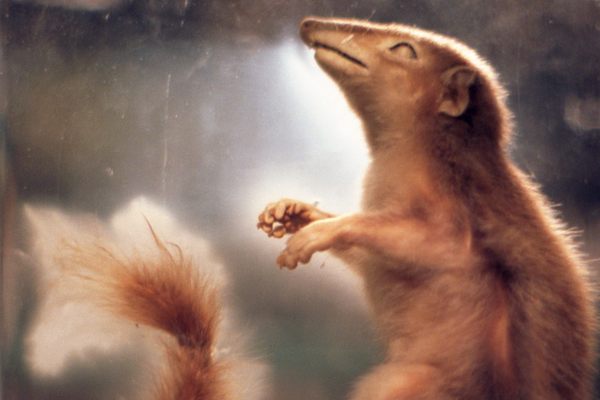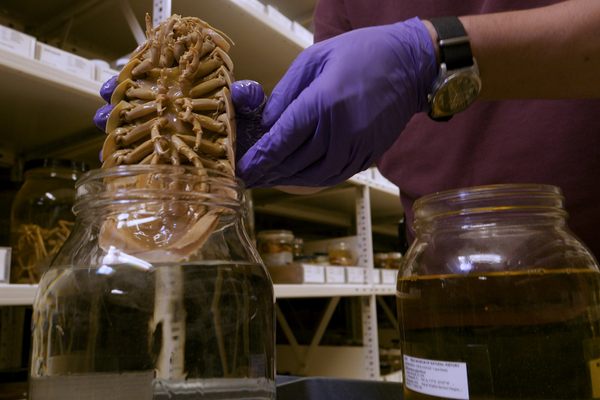From a Jar of Moles to Robot Convicts, A Visit to Five Offbeat Taxidermy Destinations
Taxidermy on the move in the Bouten Workshop in Venlo, Netherlands (all photographs by Robert Marbury)
In a digital world where technology can archive and reproduce almost anything, taxidermy holds a very peculiar status. Walter Benjamin, the early 20th-century social critic, proposed that in an age of reproduction, the aura of “oneness” lends importance to an object. In contrast to the flattening effect of digital technologies, taxidermy preserves nature in its varied singularity and serves as a perpetually decaying document, which reminds the viewer of his or her own impermanence. Although the internet has been a boon for sharing art and information about rare taxidermy collections, it is no substitute for this physical “oneness” that I relish when seeking out specimens in person.
During the first half of 2013, I traveled almost 70,000 miles to make studio visits with artists and do research for my book, Taxidermy Art (Artisan Books, 2014). Before every trip, I dug through articles and websites to find strange collections and objects to visit in each location. The internet has spread the knowledge of these unique collections more widely, but the artworks still face continued threat of extinction in the physical world, due to the financial or personal limitations of their caretakers. The loss of collections like that of Sam Sanfillippo, which was housed in a Wisconsin funeral parlor basement until his death, should serve as a reminder to us to visit these specimens while they still exist. These places that I visited while writing my book certainly merit discovery before time changes their incredible oneness, or they cease to exist all together.
The James Ford Bell Museum
Minneapolis, Minnesota
Wolf diorama at the James Ford Bell Museum
I first visited the small art deco building of the James Ford Bell Museum when Sarina Brewer, Scott Bibus, and I began the Minnesota Association of Rogue Taxidermists. This intimate collection is a keystone in the world of habitat dioramas because it contains the largest collection of environmental paintings by Frances Lee Jaques. The eponymous founder started the collection in 1872 in order to preserve the natural history unique to Minnesota, but dioramas didn’t become a focus of the museum until he became devoted to representing wolves as social hunters rather than as vermin.
Bell lured Jaques away from the American Museum of Natural History, where he had been involved in the layout and design of the mammal hall and the Whitney Bird Hall. Today, the Bell Museum hosts amazing programming, including sleepovers, sketch nights, and the discontinued flashlight tag (which unfortunately resulted in a kid’s running through the glass panel and into the Sand Hill Crane diorama). The museum is in the process of moving, which comes with its own challenges, because Jaques’s spectacular backdrops were painted directly onto the cyclorama walls. All effort is being made to preserve these dioramas in the move, and no doubt the new Bell Museum will be amazing. But if you want a first-hand experience of 1940s-style naturalism, you must visit the Bell Museum before it relocates.
Sandhill Crane diorama at the James Ford Bell Museum
Fox cub diorama at the James Ford Bell Museum
Jar of Moles
Grant Museum University College of London, England
Jar of Moles at the Grant Museum
You may be wandering the halls of University College of London looking for the famous auto-icon of Jeremy Bentham, but do not miss visiting the Grant Museum while you’re there. Just inside the door is the ultimate oracle for the modern age: a glass jar full of moles. Wet collections of multiple animals are not uncommon due to limited space and the time required to preserve animal remains; however, there is something about the “Jar of Moles” that draws visitors like few other specimens.
Perhaps it is because the jar has its own Twitter feed, which of late has taken on a political tone, or because we see those packed moles reflecting our own subway crush of modern life. Either way, it is worth a trip to stand in front of the Jar of Moles and quietly ask the kind of questions that not even Google can help you with.
Auto-icon of Jeremy Bentham
Le Comptoir Général
Paris, France
Le Comptoir Général in Paris
Down an alley off of the Canal Saint-Martin in Paris’s 10th Arrondissement is a humble corner-store sign that simply reads “Le Comptoir Général” (aka, the Ghetto Museum). From the outside appearance, it would be hard to guess what this hideaway contains. Le Comptoir Général is, in fact, a mixed-use space that offers food, drinks, shopping, events, installations, and wonder.
Devoted to the preservation of the marginal, the entire place is an elaborately decorated installation. There is a Ballroom, an Abandoned Hall, a Classroom, a Rampant Garden, and a library located in the mezzanine. When I visited, there was even a taxidermy-filled installation by Maïssa Toulet. Le Cabinet de Sorcellerie (“the witchcraft cabinet”) promised me, “the chill won’t leave your blood for hours.” The schedule of le Comptoir is erratic, but the space is always worth a visit.
Curios installed in le Comptoir Général
Convict Colonial & Robot Exhibition
Conning, Tasmania
Copping Colonial & Convict Exhibition
On the single highway that leads to Port Arthur, the famous prison colony in southeast Tasmania, just before you get to the Tasmanian Devil Conservation Park, you will see a sign on the left hand side of the road that reads: “Convict Robot Exhibition.”
Properly called the “Copping Colonial & Convict Exhibition,” the attraction is in reality a shed filled with so much stuff that you may get overwhelmed by the abundance. And did I mention Convict Robots?! These automatons are powered to do simple motions wearing masks and signs that identify their convict status. Sitting in the midst of this cacophony is a disintegrating Tasmanian devil mount, a reminder of the impermanence of nature in the midst of what was once the technology of the future. The decay and rust are authentically exciting.
Tasmanian Devil taxidermy in the Copping Colonial & Convict Exhibition
Copping Colonial & Convict Exhibition
Bouten Workshop
Venlo, Netherlands
Bouten Workshop in Venlo, Netherlands
Founded in 1918, the fourth-generation Bouten taxidermy studio is a real treasure. The taxidermists associated with the studio are known for their incredible restorations in museums throughout Europe, but their willingness to work with contemporary artists has kept them very busy. And their building is a museum in its own right, filled with taxidermy supplies and mounts for rent. The importance of this studio cannot be overstated as there would not be a tradition of taxidermy in the Netherlands had it not been for founder Jac Bouten.
After World War II, Jac helped create the Nederlandse Vereniging van Preparateurs (Dutch Union of Taxidermists), which lobbied the government for the right to practice taxidermy. The Workshop has store hours and studio visits by appointment. It is impossible to visit the studio and to speak with third- and fourth-generation owners Leon and Maurice Bouten without sensing how tradition and artistic intent can be handed down through the generations.
Bouten Workshop in Venlo, Netherlands
This Sunday, October 5, to celebrate the launch of Robert Marbury’s Taxidermy Art book, Atlas Obscura is collaborating with Morbid Anatomy on a rogue taxidermy fair at the Bell House in Brooklyn. Click here for more details & tickets >
Robert Marbury is a multidisciplinary artist and a cofounder of the Minnesota Association of Rogue Taxidermists. In addition to creating his own art, he launched the taxidermy biennial at La Luz de Jesus Gallery in Los Angeles, and co-hosts and judges the annual Carnivorous Nights Taxidermy Contest in Brooklyn. Marbury lives in Baltimore, Maryland. His first book is Taxidermy Art (Artisan Books, 2014).























Follow us on Twitter to get the latest on the world's hidden wonders.
Like us on Facebook to get the latest on the world's hidden wonders.
Follow us on Twitter Like us on Facebook